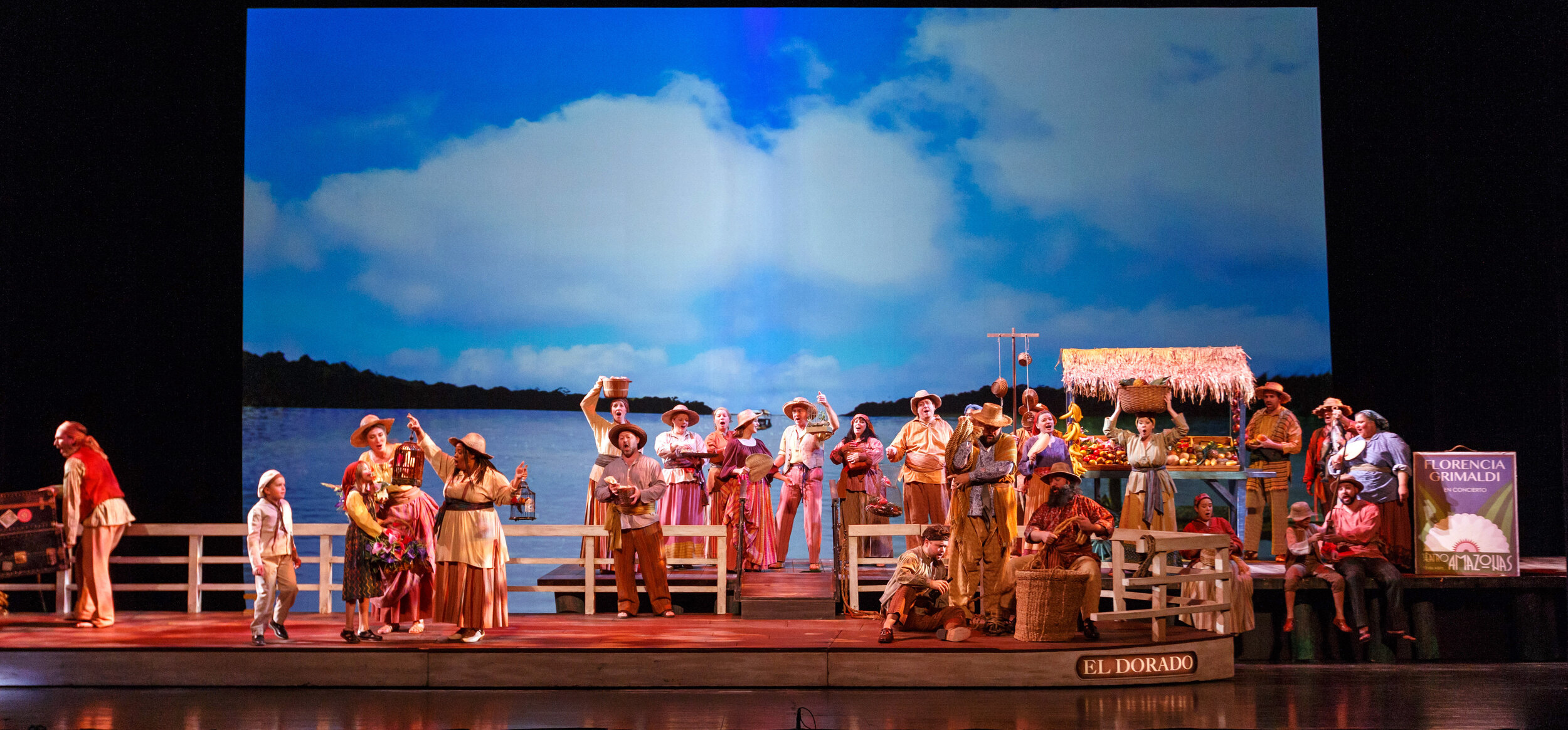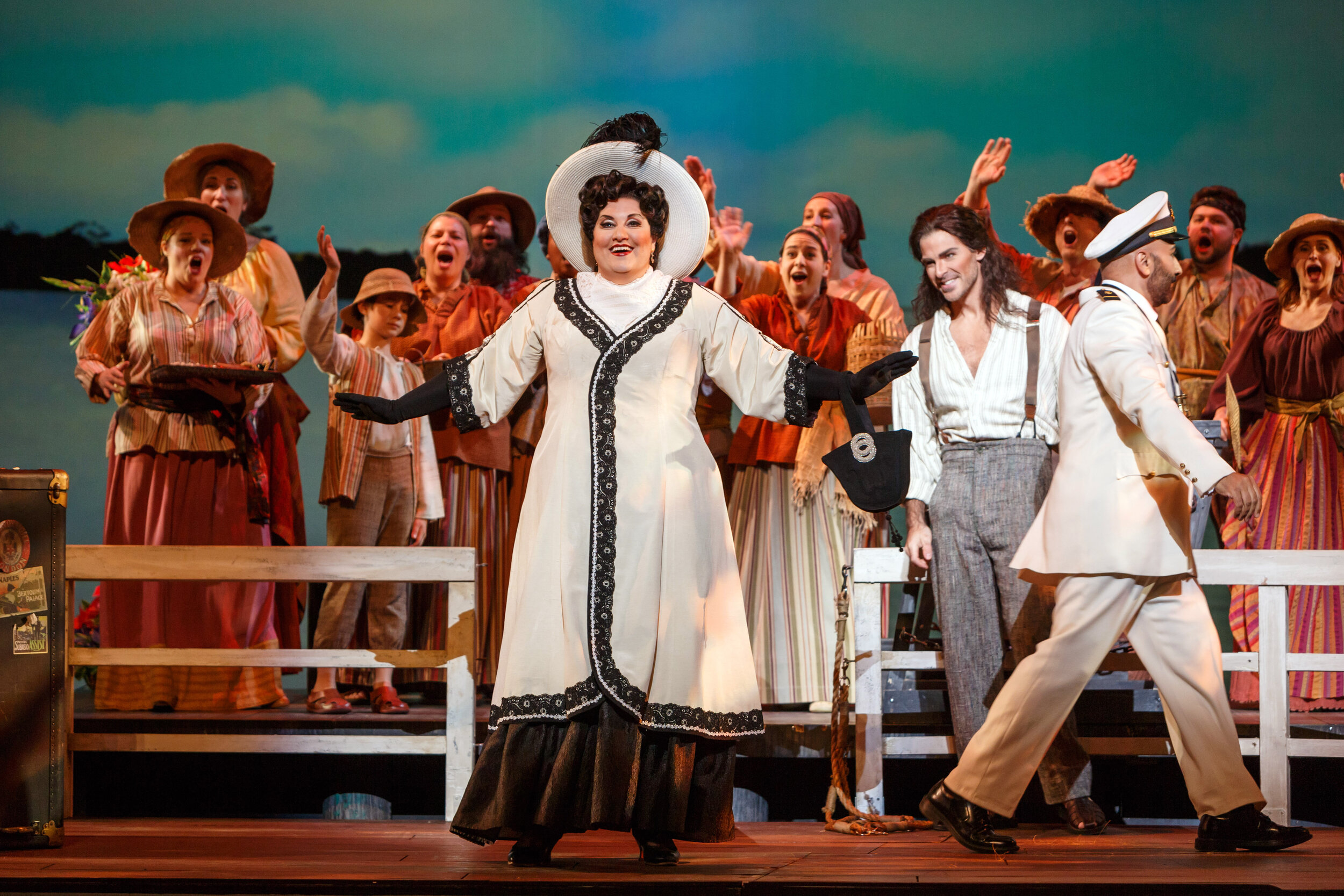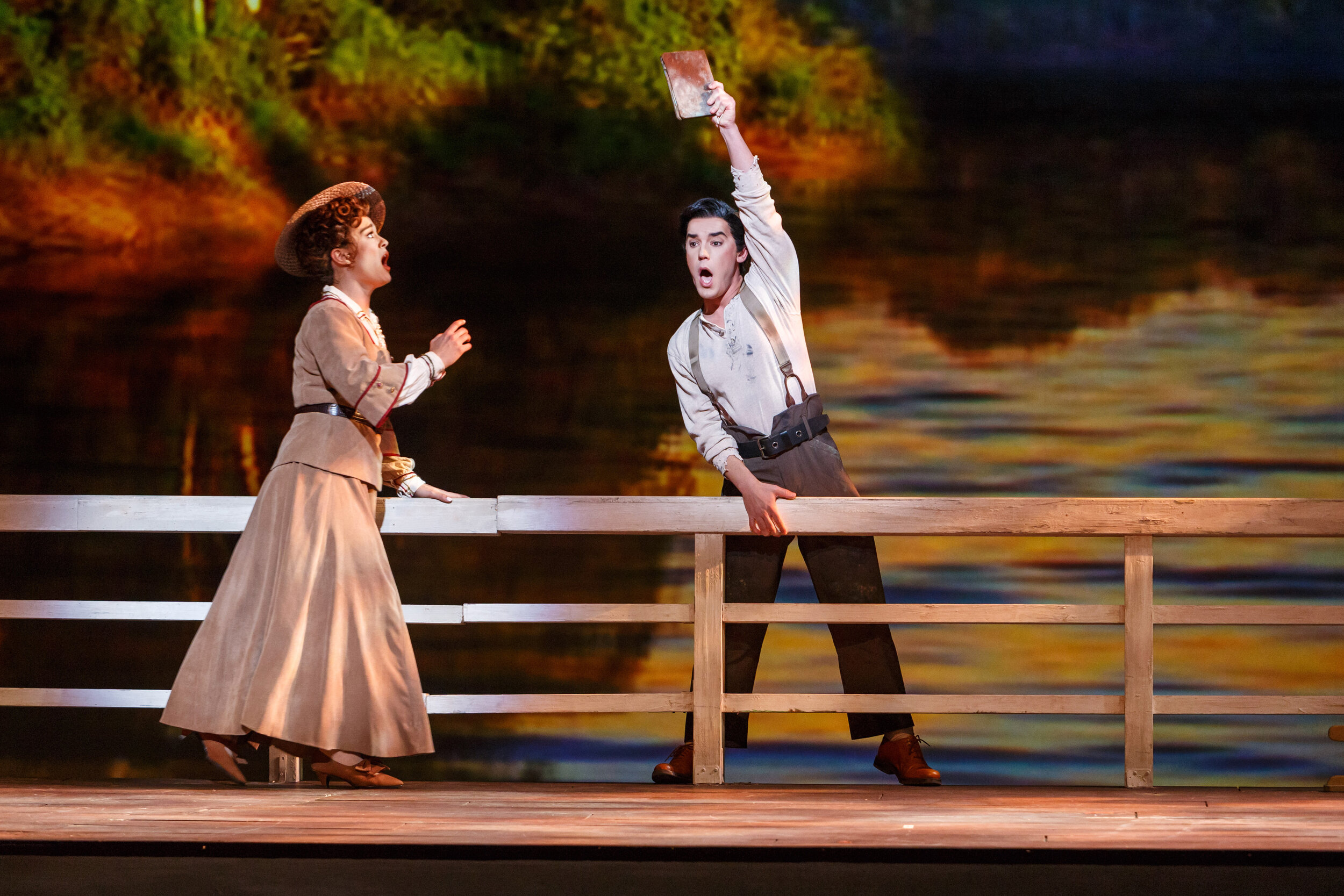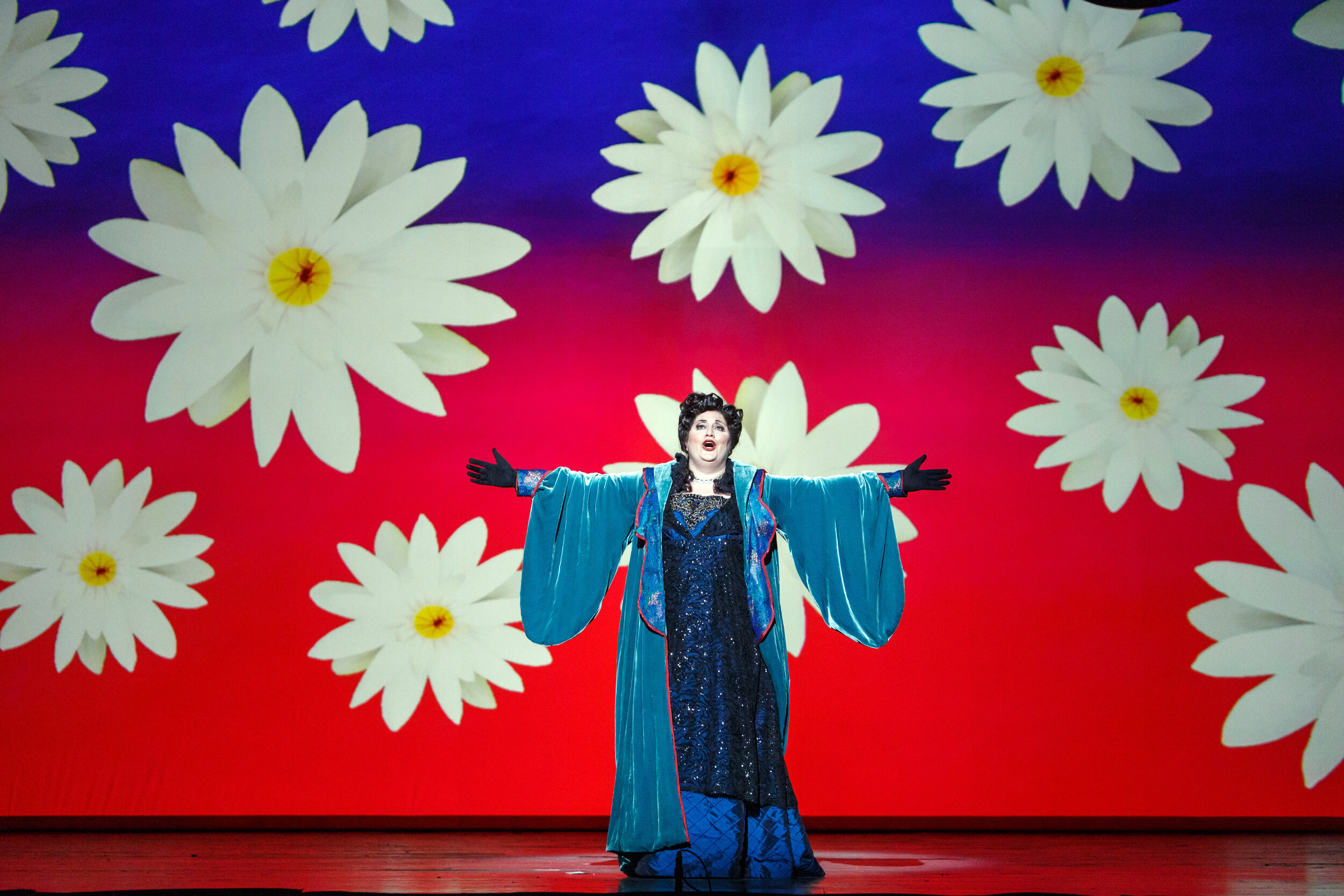Out of compassion for busy readers, I like to begin my reports on opera performances with the bottom line. If all you want to know is whether I liked it or not, you are spared reading the entire report. I sometimes read reviews where I get to the end without really knowing whether the reviewer enjoyed the performance or not. So yes, I liked Pittsburgh Opera’s Florencia en el Amazonas, but if you want to know why I recommend seeing it twice you will have to read further.
The steamboat Eldorado is boarding as Florencia en el Amazonas begins. Photo by David Bachman Photography; courtesy of Pittsburgh Opera.
Mexican composer Daniel Catán and his librettist Marcia Fuentes-Berain, once a student of Catán’s, have concocted an opera that reminds me of classic movies of old, a great story where love prevails. A voyage down a river (ask your therapist) guided by a spiritual apparition, a stalwart Capitán whose lover is life itself, his nephew trying to find himself, a young female journalist trying to find herself (already you know what is going to happen, right?), a married couple struggling to stay together, and an opera diva seeking the love of her life, Cristóbal, a butterfly hunter that she left behind to pursue her career, is the mix for this emotionally powerful drama. The story is based upon the books of Nobel Prize winning author Gabriel Garcia Márquez and is imbued with the magic realism of his writings – the magic seems to fit naturally in the story (with maybe one exception I won’t spoil for you). Catán’s music is lush and melodic with beautiful arias for all the characters; his music is said to be Puccini-like in that regard. Conductor Antony Walker, a sure hand in the pit, and the Pittsburgh Opera never sounded better to me.
left: Diva Florencia Grimaldi (Alexandra Loutsion) arrives as Riolobo (Craig Verm) looks on and the Captain (Ashraf Sewailam) moves forward. right: Rosalba (Natasha Wilson) is amazed that Arcadio (Andres Acosta) has recovered her journal dropped overboard. Photos by David Bachman Photography; courtesy of Pittsburgh Opera.
The role of Florencia Grimaldi is sung by Pittsburgh native, soprano Alexandra Loutsion. I have heard Ms. Loutsion in several performances now and her voice and vocals continue to impress. I didn’t think she displayed sufficient gravitas early on in the role, but the lyricism of her transcendent love arias in the second act carried the day. Baritone Craig Verm, who just finished appearing in PO’s Don Giovanni, is a standout visually and vocally, as the spirit Riolobo. The young journalist Rosalba is played convincingly by soprano Natasha Wilson and her duets with developing love interest Arcadio, the captain’s nephew, played by Andres Acosta, are warm and pleasing. The Capitán is sung in fine vocal form by Ashraf Sewailam, who fit the role perfectly. Finally, the married couple, Alvaro and Paula, were sung by established stars baritone Nathan Gunn and mezzo-soprano Sandra Piques Eddy. They added a sort of Fred Astaire/Ginger Rogers charm and class to the performance, even in their arguments, and for my wife, their interactions and singing together were the highlight of the performance. They were all aided by the assistance of the young cabin boy, well-played by Perry J. Gatch, IV.
Spirit Riolobo (Craig Verm) who appears where he is needed explains dinner as Alvaro (Nathan Gunn) and Paula (Sandra Piques Eddy) look on as the Cabin Boy (Perry J. Gatch, IV) displays the grilled option. Photo by David Bachman Photography; courtesy of Pittsburgh Opera.
Florencia en el Amazonas is a challenging opera to stage. After all, it involves a boat cruise down the Amazon river, including a violent storm along the way. I thought this aspect was handled effectively by a boat hull that moved back and forth across the stage and a movie screen behind it that displayed both static and moving images to create the impression of moving down the Amazon. This is a colorful production with costumes that are appealing and befit the setting. The scenes on the large screen ranged from realistic to impressionistic, from video to paintings. The staging provided an artistic backdrop to aid in the suspension of disbelief required of opera audiences. I did have the feeling of wishing to see this story in a movie with modern special effects and cinematography, but then I’d miss the live singing afforded by opera. Kudos are deserved by stage director Stephanie Havey and a long list of artistic staff involved in bringing this off.
Arcadio (Andres Acosta) takes command as he and Rosalba (Natasha Wilson) see the churning waters; the captain (Ashraf Sewailam) is downed with Paula (Sandra Piques Eddy) by his side. Photo by David Bachman Photography; courtesy of Pittsburgh Opera.
Okay, why see it twice? In a sense, I had two viewings of Florencia Saturday night, the first half con la aplicación móvil and the second, sin la aplicación móvil. Why the Spanish – you must read on. My google translate attempt at Spanish says “with the mobile app” and “without the mobile app”. This season, Pittsburgh Opera (begun with Don Giovanni) offers audiences a mobile app that provides additional opera information which can be accessed before and during performances; yes, I said “during performances”. I’m sure that the very idea makes opera purists nauseous; however, I found the concept to be intriguing and wanted to give the app a try.
To use the app, you must download the Pittsburgh Opera Mobile App to your smartphone, and to use audio in the opera house you must use earphones. Fortunately, I always have my iPhone and Air Pods with me. I dutifully downloaded the app. Surprisingly, I was unable to find instructions on the PO website on how to manage all this, which could be helpful; in fact the app seems downplayed. The app itself has a list of instructions once you dial in while inside the theater. I dimmed the brightness of the screen as low as I could and still be able to read the screen; I even shifted my screen to dark mode. I turned on the Do Not Disturb feature of my iPhone and connected the phone to my Air Pods by Bluetooth. Though I was apprehensive, no one seemed to be staring at me for wearing Air Pods, a very polite audience. I put the phone on the seat between my legs and asked my wife to tell me if the remaining light bothered her. At intermission she said it was a little distracting but okay. Nobody had asked me to turn it off nor even given me nasty looks. I did not spot anyone else close to me that I could tell was using the app. Once you click on the performance and select where next to click – before the opera, act I, intermission, act II – the app has a “Go Live” button at the bottom right to get you synced up and running.
Riolobo (Craig Verm) appears as a river-spirit to calm the storm. Photo by David Bachman Photography; courtesy of Pittsburgh Opera.
What did the mobile app offer? I was focused on the opera starting and not prepared for the first vocal message through my Air Pods; I thought someone was talking behind me at first, but I quickly got the hang of the text and vocal messages. I thought the vocal messages were much better for me than the text ones – looking over the stage for the English translations, then at the stage, then down at my iPhone was doable but a bit much. I once accidentally tapped my screen and went for a couple of minutes without realizing I needed to click Go Live again. Mostly the verbal messages seemed to slide in between vocalizations on the stage but not always; the synchronization with happenings on the stage was quite good. The verbal messages most often explained how the music was reflecting the scene; for example, during Florencia’s first aria the message named instruments in the music and how they were meant to convey the nature of the churning water; other times how the style of the singing reflected the emotions being conveyed, and so forth. There was historical information about Brazil and the geology of the Amazon given, even an attempt at humor about grilled iguana. A few important insights were given such as highlighting the captain’s comment that “no turn in life is ever a return”. One could click on highlighted words in the text to get definitions, such as for “aria”, helpful for opera newbies. There were a few pictures and there was an explanation for the map on the scrim screen on stage. There were cast member interviews during the intermission. For sure, if it’s use continues, providing the most engaging information in the most helpful way will become an art form in itself.
I had decided before coming that I would use the app for the first Act and then view Act II as usual because I had not seen the opera before. My iPhone battery reinforced that decision. If you are going to use the app, make sure you charge your phone right before coming!
l to r: Rosalba (Natasha Wilson), Arcadio (Andres Acosta), Florencia (Alexandra Loutsion), Capitán (Ashraf Sewailam), Paula (Sandra Piques Eddy), and Alvaro (Nathan Gunn) learn they cannot depart at the port because cholera is raging. Photo by David Bachman Photography; courtesy of Pittsburgh Opera.
How would I compare my experience of Act I with the app to that of Act II without the app? It’s mixed, so bear with me. My Air Pods are not noise canceling, so I did not feel deprived of sound in Act I while they sat in my ears. Mostly the app was silent, offering additional information only from time to time. The extra information provided by the app did take me a little out of the game emotionally, but on the other hand, it did add a lot of interesting insights that enhanced my appreciation for what was happening on stage and in the music. I was more involved intellectually and maybe a tad bit less emotionally.
Which do I recommend? Both. These are simply different experiences; they engage in different ways and on different levels. Perhaps a useful analogy is going through a museum and seeing the paintings without knowing much about them versus doing it with a guide who comments on the paintings, but imagine that if the paintings were videos. I missed the app during Act II, though in a way I enjoyed Act II more – maybe Act II was simply better. I’m tempted to say to use the app when you’ve seen the opera before, but not the first time. However, I really feel it is a personal choice about what you enjoy most. You might choose to get as caught up in the drama as you possibly can whether you have seen it before or not. Or you might enjoy also getting caught up in, and in a way, becoming part of the production itself, then use the app regardless. As for me, I’m not sure I can resist using the app again even for operas I have not seen before; the decision will be a struggle. Remember, these are my first impressions on using the mobile app just once.
Diva Florencia Grimaldi (Alexandra Loutsion) sings a provocative, metaphysical denouement. Photo by David Bachman Photography; courtesy of Pittsburgh Opera.
My use of the Spanish phrases is to point out that this opera is sung in Spanish. It was the first opera in Spanish I have attended. For me, I don’t speak Italian or Spanish and the similarities in the sounds of the words in both languages make them equally enjoyable to me. In fact, I was well into the opera before I noticed and reminded myself it was in Spanish.
Pittsburgh Opera’s Florencia en el Amazonas is a very enjoyable evening of compelling theater, fine operatic singing, and melodious music. The singing and the story will have you leaving the theater with a smile on your face and warmth in your heart. I strongly recommend seeing it twice, once con la aplicación móvil and once, sin la aplicación móvil. See which you like better. I like them both, though I must admit that I am leaning towards con.
The Fan Experience: In addition to what I report above about Pittsburgh Opera’s mobile app, let me add that the Benedum Center is a marvelous place to see an opera, great sound and absolutely gorgeous. Florencia en el Amazonas plays again on November 12, 15, and 17; tickets are available in all price ranges. For this one, I might recommend not to sit too close to the sides to ensure that you can see all the stage and the screen; the Pittsburgh Opera contact number for information is 412-281-0912. I hear that a new company is running the concessions and that hot dogs may be available in the future; just a rumor? Kristin Gatch, mom of the Cabin Boy and Assistant to the General Director/Board Liaison for Pittsburgh Opera, gives a pre-opera talk one hour prior to performances covering background information and snippets of the music. A guide on PO’s website with instructions for finding the mobile app, how to know you found the right app, and how and when to look for and start the app section that relates to operation during the performance, might be helpful addition.








